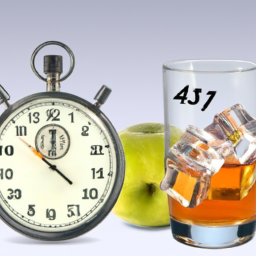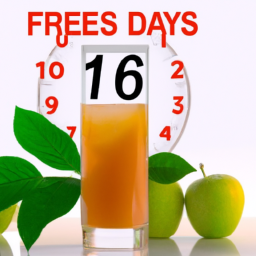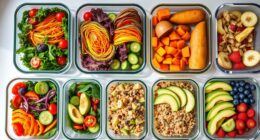On a plant-based diet, you feel full longer because the high fiber, water-rich foods, and nutrient-dense ingredients promote satiety. Fiber slows digestion and influences hunger hormones, while water content adds bulk to your stomach, signaling satisfaction. Plant proteins and low-calorie foods help you control appetite without overeating. Plus, hormonal responses from gut microbiota support longer-lasting fullness. Curious how these elements work together? Keep exploring to discover even more about what makes plant diets promote fullness.
Key Takeaways
- High water and fiber content in plant foods promote stomach stretching, signaling fullness and prolonging satiety.
- Dietary fiber slows digestion and stimulates hormones like peptide YY and GLP-1, enhancing feelings of fullness.
- Plant-based diets increase gut microbiota diversity, which positively influences appetite-regulating hormones and hunger signals.
- Protein-rich plant foods activate metabolic pathways that support sustained fullness and regulate hunger hormones.
- The low energy density of plant foods allows for larger portions, providing volume and satisfaction with fewer calories.
Key Nutrients Contributing to Feeling Full
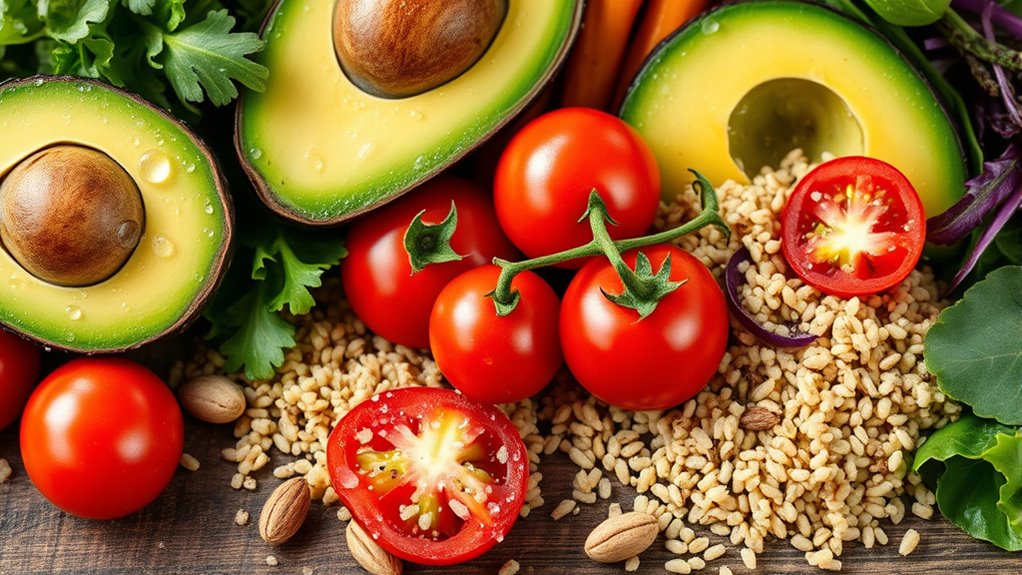
Certain nutrients play an essential role in promoting feelings of fullness on a plant-based diet. Protein-rich foods like beans, lentils, and tofu activate metabolic pathways that help you feel satisfied longer. These pathways influence hormones involved in satiety, counteracting common satiety myths that carbs alone keep you full. Additionally, nutrient-dense foods provide a range of compounds that support overall health and satiety by engaging multiple metabolic processes. Incorporating high-quality protein sources can further enhance feelings of fullness and help regulate appetite more effectively. Unlike the misconception that plant-based diets lack satisfying nutrients, these key components support your fullness through complex biochemical processes. A variety of whole foods play a crucial role in maintaining satiety and providing essential nutrients vital for overall well-being. By focusing on whole, nutrient-dense foods, you enhance your body’s natural signals for fullness. Understanding how these nutrients interact with your body’s metabolic pathways makes it clear why plant-based diets can effectively curb hunger without relying solely on fiber or calorie restriction. Including fiber-rich foods can also promote satiety by slowing digestion and stabilizing blood sugar levels. Incorporating heartfelt and inspiring foods can further boost your motivation to maintain satiety and enjoy your dietary journey. This knowledge empowers you to make smarter, satiety-boosting food choices.
The Role of Dietary Fiber in Satiety
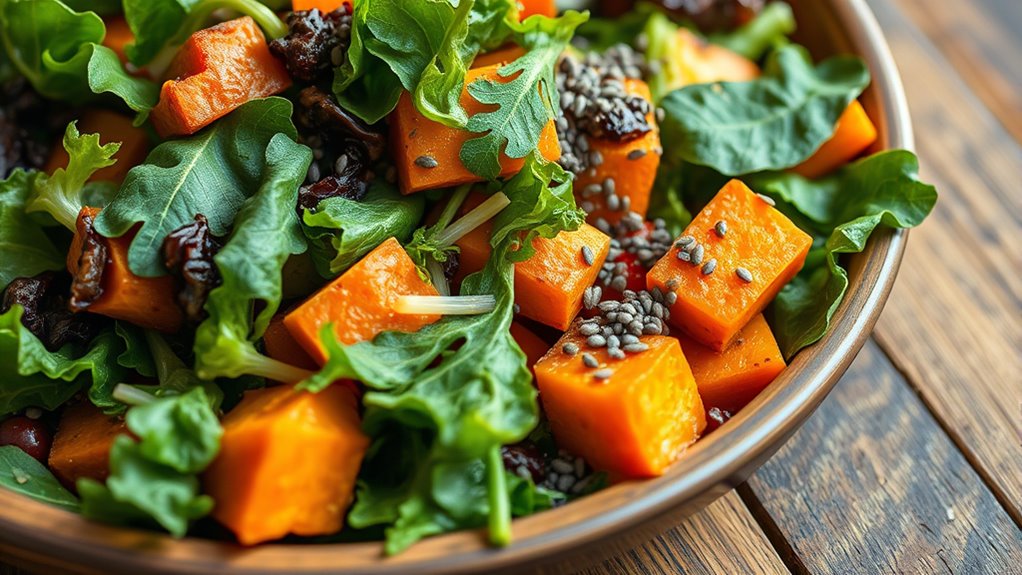
Dietary fiber plays a vital role in making you feel full by slowing down digestion and promoting a steady release of nutrients. It also helps regulate satiety hormones, keeping hunger at bay longer. Understanding how fiber influences these processes can help you choose plant-based foods that support lasting fullness. Additionally, incorporating nutrient absorption principles into your diet planning can help identify potential vulnerabilities in your nutritional habits, ensuring consistent healthy choices.
Fiber’s Digestive Impact
Because dietary fiber plays a crucial role in digestion, it considerably influences feelings of fullness on plant-based diets. Fiber reaches your gut largely undigested, where it interacts with gut bacteria during fermentation processes. This fermentation produces short-chain fatty acids that help slow gastric emptying, prolonging satiety. Additionally, the buildup of fiber adds bulk to your stool, aiding regularity and reducing hunger signals. The presence of fiber also supports a healthy gut microbiome, which can enhance digestion and nutrient absorption. As fermentation continues, your gut bacteria generate byproducts that send signals to your brain, reinforcing feelings of fullness. Incorporating various types of dietary fiber can help maintain scalp health and comfort during dietary changes. Including soluble and insoluble fiber sources is essential for a comprehensive digestive strategy, promoting overall gut health and satiety. Recognizing the importance of indoor gardening options can be beneficial for those looking to grow fresh herbs and vegetables at home, further supporting a sustainable and healthy diet. Moreover, a diverse range of fiber sources can contribute to a more balanced gut microbiome, improving overall digestive health and satiety. Overall, fiber’s impact on digestion not only promotes gut health but also helps you stay satisfied longer after meals, making it a key component of satiety on plant-based diets.
Satiety Hormone Regulation
Fiber’s fermentation in your gut doesn’t just promote digestion; it also influences hormones that regulate hunger and fullness. When your gut microbiota ferments fiber, it produces short-chain fatty acids that impact satiety hormones like leptin and ghrelin, helping you feel full longer. This process can modulate your metabolic rate, making your body more efficient at burning calories and managing energy balance. By supporting a healthy gut microbiota, fiber helps maintain balanced hormone levels that control appetite signals. Additionally, gut microbiota diversity plays a crucial role in optimizing these hormonal responses. As a result, high-fiber diets enhance your sense of fullness, reduce overeating, and promote sustained satiety. Understanding how fiber influences these hormones underscores its essential role in managing hunger naturally, especially on plant‑based diets that are rich in diverse, fiber-dense foods. Dietary fiber’s impact on gut microbiota further emphasizes its importance in hormone regulation and appetite control.
Moreover, the use of cookies and other tracking technologies can help analyze how dietary changes influence user engagement with health information.
Protein Power: How Plant-Based Proteins Promote Fullness
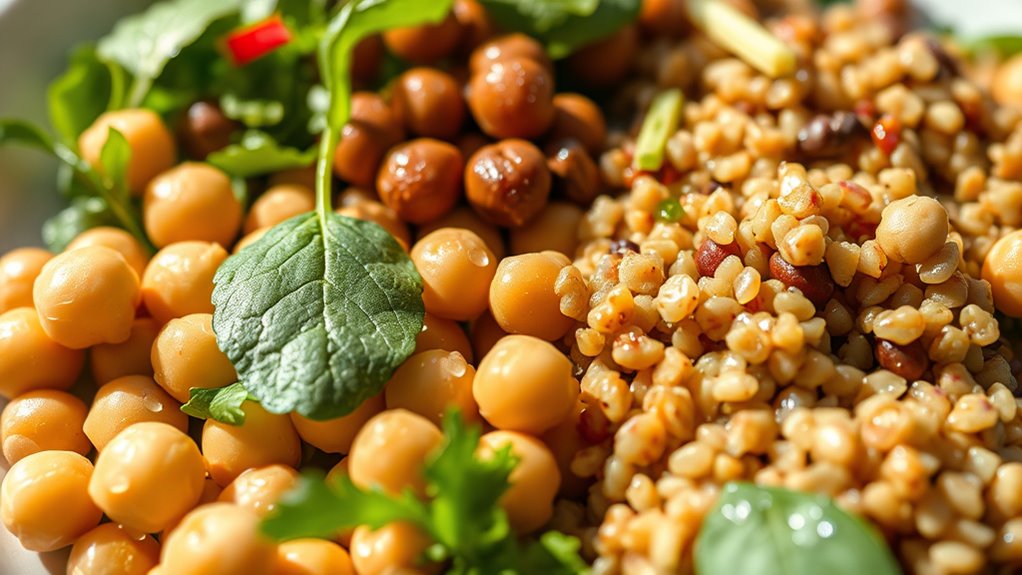
Plant-based proteins are surprisingly effective at helping you feel full longer, making them a valuable tool for satiety. They contain ample protein from sources like beans, lentils, tofu, and quinoa, which help keep hunger at bay. Unlike animal proteins, many plant protein sources have diverse amino acid profiles, contributing to sustained fullness. Here’s how they boost satiety: 1. They provide high-quality protein that activates hunger-suppressing hormones. 2. Their fiber content slows digestion, prolonging feelings of fullness. 3. The variety in amino acid profiles enhances muscle maintenance and overall satisfaction. Additionally, incorporating essential oils such as peppermint or citrus oils in aromatherapy can promote relaxation and reduce stress-induced eating, further supporting satiety.
The Impact of Water Content and Volume in Plant Foods
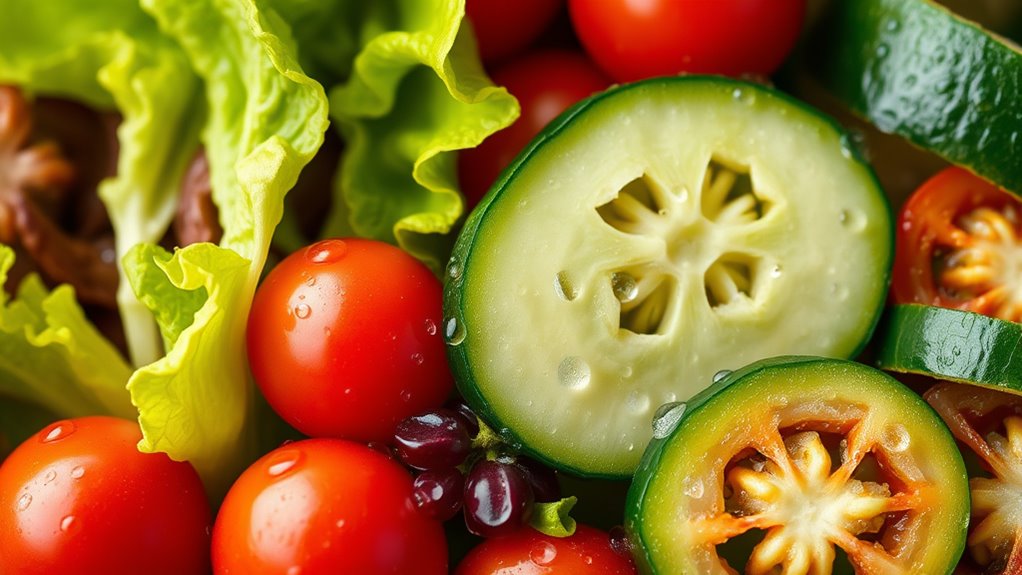
Water-rich fruits and vegetables add bulk to your meals, helping you feel full longer. Their high volume creates a stretching sensation in your stomach, signaling satiety. Incorporating these foods can naturally curb overeating and support your diet goals. Additionally, the coastal zones influenced by wave action and tidal movements often contain abundant plant life that contributes to local diets. The high water content in plant foods also plays a role in supporting metabolism and overall hydration.
Water-Rich Fruits and Vegetables
Because they contain a high percentage of water, fruits and vegetables with low energy density can help you feel full while consuming fewer calories. Their water content promotes hydration effects, supporting overall health and satiety. Plus, their natural moisture enhances flavor, making meals more satisfying without added fats or sugars. Incorporating these foods into your diet can also help with weight management by increasing volume without extra calories. Here are some benefits:
- Boosts hydration, improving energy and focus.
- Enhances flavor naturally, reducing the need for salt or sugar.
- Promotes fullness with fewer calories, aiding weight control.
Volume and Digestive Stretching
The high water content and volume of many plant foods play a crucial role in promoting digestive stretching, which can help you feel full longer. When you eat foods with significant water and fiber, your stomach capacity increases, leading to a sensation of fullness. This stretching of your stomach slows down digestion speed, making nutrients stay longer and reducing hunger between meals. Because plant foods often have low energy density, you can consume larger portions without overeating. The expanded stomach capacity signals to your brain that you’re satisfied, helping prevent overeating later. Additionally, incorporating low-calorie, high-volume foods can further enhance satiety and support weight management. By choosing foods rich in volume, you support sustained satiety through slower digestion and enhanced digestive stretching, making it easier to maintain a healthy, plant-based diet while keeping hunger at bay.
Hormonal Responses and Satiety Signals
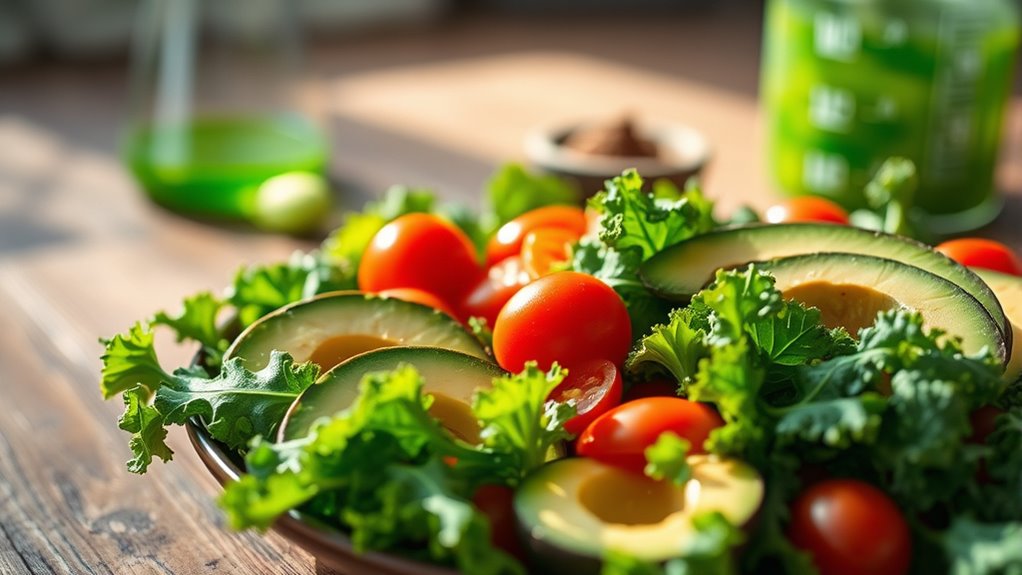
How do plant-based diets influence your body’s hormonal signals that regulate hunger and fullness? They activate hormonal pathways that enhance appetite regulation, helping you feel satisfied longer. Plant foods are rich in fiber, which promotes the release of hormones like peptide YY and GLP-1 that signal fullness. Additionally, they help modulate ghrelin, the hunger hormone, reducing unnecessary cravings. Here’s how it works:
Plant-based diets boost fullness hormones, curb hunger, and stabilize blood sugar for lasting satisfaction.
- Fiber stimulates satiety hormones, extending feelings of fullness.
- Plant compounds influence hormonal pathways to suppress hunger signals.
- Stable blood sugar levels from plant foods prevent spikes that trigger hunger.
- Using Free Floating techniques in backyard designs can create relaxing environments that complement healthy lifestyles.
Comparing Plant-Based and Animal-Based Diets in Satiety

When comparing plant-based and animal-based diets, you’ll notice significant differences in how each influences feelings of fullness. Plant-based diets often promote a higher gut microbiome diversity, which can enhance satiety signals and improve digestion. They tend to have a lower energy density, helping you feel full without overeating. Conversely, animal-based diets may boost your metabolic rate temporarily but can lead to less sustained satiety due to differences in fiber content and gut health. The fiber in plant foods slows digestion and stabilizes blood sugar, prolonging feelings of fullness. In contrast, high-protein animal foods can spike satiety initially but might not support long-term fullness as effectively. Overall, your gut microbiome plays a vital role in how these diets influence satiety, affecting both your hunger and metabolic responses.
Frequently Asked Questions
How Do Micronutrients Influence Feelings of Fullness on a Plant-Based Diet?
Micronutrients play a key role in your feelings of fullness on a plant-based diet by supporting micronutrient absorption and boosting nutrient density in your meals. When you consume nutrient-dense foods rich in vitamins and minerals, your body signals fullness more effectively. Proper micronutrient intake helps regulate hunger hormones, making you feel satisfied longer and reducing overeating. So, prioritizing micronutrients enhances satiety, helping you stay full and energized throughout the day.
Can Cooking Methods Affect Satiety Levels in Plant Foods?
Imagine your plant foods transforming with cooking techniques and texture modifications; this change can boost your satiety. For example, steaming or roasting enhances flavors and alters texture, making you feel fuller longer. Conversely, overcooking might reduce fiber content and decrease satiety. So, by choosing the right cooking methods, you can maximize fullness from your plant-based meals, keeping you satisfied and energized throughout the day.
Are There Differences in Satiety Between Processed and Whole Plant Foods?
You’ll find that whole plant foods generally promote greater satiety than processed ones because they have higher fiber content and lower glycemic index. Fiber slows digestion, keeping you full longer, while a lower glycemic index prevents rapid blood sugar spikes that can trigger hunger. Processed foods often lose fiber and have higher glycemic index, leading to less satiety. So, choosing whole plant foods helps you stay satisfied longer and supports better appetite control.
How Does Meal Timing Impact Satiety on a Plant-Based Diet?
Meal timing can be your secret weapon, like a conductor leading a symphony of satiety. When you align meal timing with fasting windows, you help regulate hunger hormones and stabilize blood sugar levels. Eating at regular intervals guarantees consistent satiety, preventing overeating. Skipping meals or irregular timing can leave you starving later. So, plan your meals to match your fasting windows, and you’ll stay full and energized longer.
Do Plant-Based Diets Affect Long-Term Appetite Regulation Differently?
You might notice that plant-based diets influence long-term appetite regulation through fiber digestion and hormonal responses. The high fiber content slows digestion, helping you feel full longer, while hormonal signals like insulin and leptin help control hunger. Over time, these effects can lead to better appetite management. So, yes, plant-based diets can modify your hunger cues differently, promoting sustained satiety and supporting healthy weight maintenance.
Conclusion
Understanding how plant-based diets keep you feeling full is like revealing a secret recipe. By focusing on fiber, protein, and water-rich foods, you’re fueling your body with nature’s own fullness formula. Think of it as setting your internal thermostat—when you eat the right plant foods, you’ll stay satisfied longer. Embrace these science-backed tips, and watch your hunger fade like a distant echo, leaving you energized and happily full.
Hi, I’m Alexander. I’m a vegan of over 20 years, and I initially made the switch for health reasons. However, as time went on, I became more and more passionate about the ethical and environmental implications of leading a vegan lifestyle.
I am the author of The Graceful Kitchen, a vegan blog where I share recipes for delicious and nutritious vegan meals. As someone who is deeply committed to living a cruelty-free life, I am also a strong advocate for using whole foods as the foundation of a healthy diet – and believe that going vegan is one of the best ways to achieve this.



